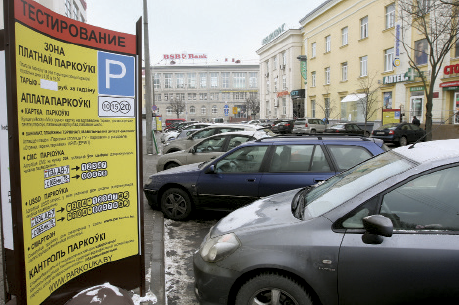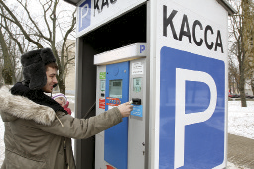
Parking places work in new mode
It’s high time for Minsk to focus on this problem. According to experts, ecological problems come to light when the number of cars per capita reaches 315. The city’s general plan of development envisages corresponding measures to reduce the number of private automobiles. These were previously planned to be put into operation in 2015 but the document authors made a mistake in their calculations: Belarusians have been actively buying cars and the permissible level has already passed.
It might seem at first sight, to those unaware of the issues that the expansion of paid parking places would alleviate the tension, but this is not entirely true. High prices would deter some drivers from entering the busy city centre. The experience of western cities shows that additional expenses on personal transport reduces car activity, encouraging city dwellers to turn to public transport. However, it’s not yet known whether similar measures would inspire Belarusians to exchange the convenience of the driver’s seat for buses, tram or the metro.
The issue is complicated. Personal transport does not actually exist in isolation; rather, it’s an element of the city’s infrastructure. The problem will not be solved with mere tariff regulation. Yuri Vazhnik, the Chairman of the Belarusian Association of Experts and Transport Surveyors, compares drivers to water: if an obstacle emerges in one place, water smoothly moves to another. He believes that people would begin leaving their cars on the outskirts once parking charges are put into operation. With this in mind, the problem of parking spaces must be studied so as to achieve results; detailed research is needed into both the transport and the sociological effects and causes. Much depends on people’s reaction. How would drivers act if parking becomes paid in areas overwhelmed with cars? Some would pay willingly, while others would start searching for free spaces in neighbouring streets, considering that several hundred metres walk would compensate for the potential expense of parking in a convenient place. Others will, of course, turn to public transport.

Payment through terminal
In general, Mr. Vazhnik is convinced that free parking would cost too much for the city in the long term. The railway station serves as an example, when its parking was free, some travellers left their cars there for several days. They would arrive by car, change for the train and go to Moscow, for example. After returning to Minsk, they’d find it convenient to have their cars parked nearby. As a result, the number of free parking places near the railway station could be increased to infinity, but they would always be fully occupied. Sweden for example, has introduced a different practice: automatic parking meters. They allow 5 minutes free time, with $5 taken for a further hour-long period.
Meanwhile, the attraction of public transport must grow proportionally with the increase of expenses of individual cars’ use. It’s not a problem to make these expenses high, but whether public transport would be able to service at least a part of Minsk’s 750,000 individual car drivers is questionable.
By Vladimir Volokhovsky












